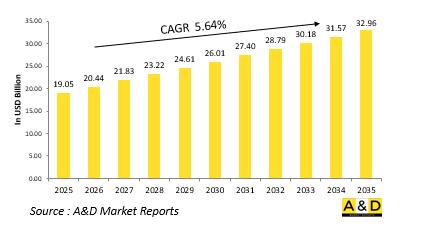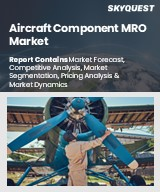
|
시장보고서
상품코드
1706583
세계의 항공우주 방위용 아비오닉스 시장(2025-2035년)Global Aerospace Defense Avionics Market 2025-2035 |
||||||
세계의 항공우주 방위용 아비오닉스 시장 규모는 2025년 15억 7,000만 달러로 추정됩니다. 2035년까지 32억 8,000만 달러로 성장할 것으로 예상되며, 예측기간의 2025-2035년 연간 평균 성장률(CAGR)은 7.65%를 나타낼 전망됩니다.

항공우주 방위용 아비오닉스 시장 서론 :
항공우주 방위용 항공기는 전투기, 폭격기, 운송기, 무인 항공기(UAV), 헬리콥터 등 군용기에서 사용되는 전자 시스템 및 서브시스템을 가리킵니다. 세계의 항공우주 방위용 아비오닉스 시장은 국가안보, 전력투사, 전략적 방위계획에 있어 중요한 역할을 하고 있습니다.
항공우주 방위용 아비오닉스 시장에서의 기술 영향 :
기술은 전례 없는 속도로 항공우주 방위용 아비오닉스를 변화시키고 있습니다. 이 모듈화는 라이프사이클 비용을 절감하고 군는 플랫폼 전체를 오버홀하지 않고 보다 새로운 기술을 통합함으로써 새로운 위협에 신속하게 대응할 수 있게 됩니다. 데이터를 실시간으로 분석하고, 파일럿과 운영자가 잠재적인 위협을 파악하고, 목표에 우선순위를 부여하고, 미션 매개변수를 보다 빠르고 정확하게 최적화하는 데 도움이 됩니다. 전자전이나 ISR(첩보·감시·정찰) 작전에 있어서 매우 중요합니다.차세대 디스플레이와 증강현실(AR)도, 콕피트 환경을 재구축하고 있습니다. 파노라마 터치 스크린은 파일럿에 직관적인 인터페이스를 제공하여 상황 인식을 높이고 인지 작업 부하를 줄입니다. 그리고, 파일럿의 시야에 새로운 정보층이 더해져, 보다 신속하고 정보에 근거한 의사 결정이 가능하게 됩니다. 항공기 시스템의 네트워킹이 진행됨에 따라 사이버 위협에 대한 취약성이 커지고 있습니다. 아비오닉스 네트워크를 보호하고 있습니다. 복수의 센서 입력을 조합해 하나의 정합된 이미지를 작성하는 센서 퓨전의 진보는 검출 정밀도와 위협에 대한 대응을 대폭 향상시킵니다. AESA(Active Electronically Scanned Array) 레이더와 같은 최신 레이더 시스템은 IRST(적외선 검색 및 추적), 전자 지원 수단, 패시브 센서와 통합되어 공대공, 공대지, 해상 모니터링을 위한 다중 도메인 능력을 제공합니다.
항공우주 방위용 아비오닉스 시장 주요 성장 촉진요인:
세계의 항공우주 방위용 아비오닉스 시장은 전략적, 운용적, 기술적 요인의 조합에 의해 견인되고 있습니다. 새로운 플랫폼으로 대체하거나 아비오닉스를 업그레이드하여 운영상의 적합성을 유지하려고 노력하고 있습니다. 보다 효율적인 미션·제어·시스템 등이 포함되는 경우가 많습니다. 지정학적 긴장과 지역 분쟁도 시장의 중요한 촉진요인이 되고 있습니다.
UAV와 무인 전투기(UCAV)의 보급은 아비오닉스의 기술 혁신에 새로운 길을 열었습니다. 대부분의 경우 매우 까다로운 조건에서 사용됩니다. 이 하위 부문에서는 안전한 데이터 링크, 센서 통합 및 AI 지원 네비게이션에 대한 수요가 급속히 증가하고 있습니다. 현대의 전쟁은 더 이상 하늘, 육지, 바다에 한정되는 것이 아니라, 사이버나 우주 영역에도 미치고 있습니다. 미국 국방부의 합동 전영역 지휘 및 통제(JADC2)와 유럽의 미래 전투 항공 시스템(FCAS) 같은 프로그램은 더 빠른 데이터 공유, 센서 통합, 임무 자율성에 중점을 둔 항공 전자 기술의 혁신을 촉진하고 있습니다.
항공우주 방위용 아비오닉스 시장 지역 동향 :
항공우주 방위용 아비오닉스 시장은 군사적 우선사항, 방위 예산, 고유 능력에 근거하여 명확한 지역 동향을 나타내고 있습니다. 팀과 같은 프로그램을 위해 항상 최첨단 에비오닉스에 투자하고 있습니다.
유럽은 또한 중요한 시장이며 영국의 템페스트, 프랑스, 독일, 스페인의 FCAS, 유로파이터, 타이푼 함대의 지속적인 업그레이드 등의 프로그램에 의해 견인되고 있습니다. 독일(헨솔트), 영국(BAE 시스템즈) 등 국가들은 강력한 국내 아비오닉스 제조능력이 있습니다. 아비오닉스에 있어서의 존재감을 급속히 확대하고 있습니다. 인도는 테자스와 AMCA 계획에서 이를 추종하고 있으며 해외 공급업체에 대한 의존을 줄이기 위해 국산 아비오닉스의 개발을 목표로 하고 있습니다.
주요 항공우주 방위용 아비오닉스 프로그램 :
GE Aerospace는 세계의 F/A-18, AV-8B, AH-1Z 항공기의 아비오닉스 시스템의 퍼포먼스 베이스 로지스틱스(PBL) 지원을 제공하는 계약을 획득했습니다. Aerospace는 예비 부품 공급 체인, 창고 관리 및 물류를 관리하고 항공기 부품 및 서브 어셈블리의 저장소 수리 서비스를 제공합니다.
RTX의 자회사인 Collins Aerospace는 미국 육군 H-60M 헬리콥터의 아비오닉스 시스템의 모듈식 오픈 시스템 아키텍처를 개발하기 위해 8,000만 달러의 비용 플러스 고정 보상 계약을 획득했습니다. 이에 따라 자금과 작업장은 태스크 오더별로 결정됩니다. 계약은 2029년 3월 7일까지 완료될 예정입니다.
본 보고서에서는 세계의 항공우주 방위용 아비오닉스 시장에 대해 조사했으며, 10년간의 부문별 시장 예측, 기술 동향, 기회 분석, 기업 프로파일, 국가별 데이터 등을 정리했습니다.
목차
항공우주 방위용 아비오닉스 시장 보고서 정의
항공우주 방위용 아비오닉스 시장 세분화
향후 10년간 항공우주 방위용 아비오닉스 시장 분석
이 장에서는 10년간의 항공우주 방위용 아비오닉스 시장 분석을 통해 항공우주 방위용 아비오닉스 시장의 성장, 변화하는 추세, 기술 채용 개요 및 전체 시장의 매력 상세한 개요를 제공합니다.
항공우주 방위용 아비오닉스 시장 기술
이 부문에서는 이 시장에 영향을 미칠 것으로 예상되는 상위 10개 기술과 이러한 기술이 시장 전반에 미칠 수 있는 영향에 대해 설명합니다.
세계의 항공우주 방위용 아비오닉스 시장 예측
이 시장의 10년간의 항공우주 방위용 아비오닉스 시장 예측은 위의 전체 부문에 걸쳐 상세하게 설명되어 있습니다.
지역별 항공우주 방위용 아비오닉스 시장 동향과 예측
이 부문은 지역별 항공우주 방위용 아비오닉스 시장 동향, 촉진요인, 제약 요인, 과제, 그리고 정치, 경제, 사회, 기술 등의 측면을 망라하고 있습니다. 또한 지역별 시장 예측과 시나리오 분석도 자세히 다루고 있습니다. 지역 분석의 끝에는 주요 기업 프로파일링, 공급업체 상황, 기업 벤치마킹이 포함됩니다. 현재 시장 규모는 일반적인 시나리오를 기반으로 추정됩니다.
북미
성장 촉진요인, 성장 억제요인, 과제
PEST
시장 예측 및 시나리오 분석
주요 기업
공급업체 계층의 상황
기업 벤치마킹
유럽
중동
아시아태평양
남미
항공우주 방위용 아비오닉스 시장의 국가별 분석
이 장에서는 이 시장에서 주요 방위 프로그램을 다루며 이 시장에서 신청된 최신 뉴스와 특허에 대해서도 설명합니다. 또한 국가 수준의 10년간 시장 예측과 시나리오 분석에 대해서도 설명합니다.
미국
최신 뉴스
특허
이 시장의 현재 기술 성숙도
시장 예측 및 시나리오 분석
캐나다
이탈리아
프랑스
독일
네덜란드
벨기에
스페인
스웨덴
그리스
호주
남아프리카
인도
중국
러시아
한국
일본
말레이시아
싱가포르
브라질
항공우주 방위용 아비오닉스 시장 기회 매트릭스
항공우주 방위용 아비오닉스 시장 보고서에 관한 전문가의 의견
결론
항공 및 방위 시장 보고서에 대해서
KTH 25.04.28The Global Aerospace Defense Avionics market is estimated at USD 1.57 billion in 2025, projected to grow to USD 3.28 billion by 2035 at a Compound Annual Growth Rate (CAGR) of 7.65% over the forecast period 2025-2035.

Introduction to Aerospace Defense Avionics Market:
Aerospace defense avionics refers to the electronic systems and subsystems used in military aircraft, including fighters, bombers, transport planes, unmanned aerial vehicles (UAVs), and helicopters. These systems include navigation, surveillance, communication, radar, electronic warfare, flight control, mission planning, and cockpit instrumentation. The global aerospace defense avionics market plays a crucial role in national security, force projection, and strategic defense planning. As threats evolve and defense strategies shift toward multi-domain operations, avionics systems have become essential for ensuring situational awareness, mission effectiveness, and operational readiness.
Technology Impact in Aerospace Defense Avionics Market:
Technology is transforming aerospace defense avionics at an unprecedented pace. One of the most significant changes is the integration of open architecture systems, allowing for plug-and-play capabilities and faster upgrades. This modularity reduces lifecycle costs and enables armed forces to adapt quickly to emerging threats by integrating newer technologies without needing to overhaul entire platforms. Artificial intelligence (AI) and machine learning (ML) are being embedded into avionics systems to automate decision-making, threat detection, and data analysis. AI-driven avionics can analyze vast amounts of sensor data in real-time, helping pilots and operators identify potential threats, prioritize targets, and optimize mission parameters with greater speed and accuracy. This is particularly crucial in electronic warfare and ISR (Intelligence, Surveillance, and Reconnaissance) operations. Next-generation displays and augmented reality (AR) are also reshaping cockpit environments. Helmet-mounted displays (HMDs) and panoramic touchscreens provide intuitive interfaces for pilots, enhancing situational awareness and reducing cognitive workload. The use of AR in mission rehearsal and in-flight navigation adds an additional layer of information to the pilot's field of vision, enabling faster and more informed decision-making. Cybersecurity has become a core concern in modern avionics design. As aircraft systems become more networked, they are increasingly vulnerable to cyber threats. This has led to the incorporation of secure data links, encrypted communications, and intrusion detection systems to protect avionics networks from hostile intrusions and spoofing. Advancements in sensor fusion, where multiple sensor inputs are combined to create a single cohesive picture, significantly improve detection accuracy and threat response. Modern radar systems such as AESA (Active Electronically Scanned Array) radars, integrated with IRST (Infrared Search and Track), electronic support measures, and passive sensors, provide multi-domain capabilities for air-to-air, air-to-ground, and maritime surveillance.
Key Drivers in Aerospace Defense Avionics Market:
The global aerospace defense avionics market is driven by a combination of strategic, operational, and technological factors. Foremost among them is the rising demand for fleet modernization. Many air forces across the globe are replacing legacy systems with newer platforms or upgrading their avionics to remain operationally relevant. These upgrades often include enhanced communication systems, modern radars, electronic warfare suites, and more efficient mission control systems. Geopolitical tensions and regional conflicts have also become significant market drivers. As global power dynamics shift and new threats emerge-from both state and non-state actors-nations are prioritizing air superiority and battlefield awareness. This has led to increased defense budgets in key regions and an emphasis on advanced avionics for early warning, rapid response, and force protection.
The proliferation of UAVs and unmanned combat aerial vehicles (UCAVs) has opened new avenues for avionics innovation. These systems require compact, autonomous avionics suites that can support real-time communication, surveillance, and weapons delivery, often under highly contested conditions. The demand for secure data links, sensor integration, and AI-enabled navigation is growing rapidly in this sub-sector. Another major driver is the increasing focus on multi-domain operations (MDO). Modern warfare is no longer confined to air, land, or sea-it spans cyber and space domains as well. Avionics systems that can communicate and coordinate across all these spheres are in high demand. The need for interoperability among allied forces further reinforces the push for standardized and adaptable avionics architectures. Additionally, R&D investments and defense-industrial collaborations between governments and private firms are propelling the market forward. Programs like the U.S. Department of Defense's Joint All-Domain Command and Control (JADC2) and the European Future Combat Air System (FCAS) are fostering innovation in avionics technologies that focus on faster data sharing, sensor integration, and mission autonomy.
Regional Trends in Aerospace Defense Avionics Market:
The aerospace defense avionics market exhibits distinct regional trends based on military priorities, defense budgets, and indigenous capabilities. North America, particularly the United States, leads the global avionics market both in terms of technological development and procurement. The U.S. Department of Defense consistently invests in cutting-edge avionics for programs like the F-35 Lightning II, B-21 Raider, and various UAV platforms. The country is also a leader in developing AI-driven systems, cyber-secure avionics, and electronic warfare solutions. Canada also contributes to the market with its focus on NORAD modernization and multi-role fighter acquisitions.
Europe is another significant market, driven by programs such as the UK's Tempest, France-Germany-Spain's FCAS, and continued upgrades to Eurofighter Typhoon fleets. The region emphasizes interoperability within NATO and has strong domestic avionics manufacturing capabilities in countries like France (Thales), Germany (Hensoldt), and the UK (BAE Systems). Environmental concerns and export control laws shape how systems are designed, manufactured, and shared across borders. Asia-Pacific is rapidly expanding its presence in aerospace defense avionics. China is heavily investing in indigenous avionics systems for platforms like the J-20 stealth fighter and its expanding UAV fleet. Emphasis is placed on achieving technological self-sufficiency, especially in the face of export restrictions. India is following suit with its Tejas and AMCA programs, aiming to develop homegrown avionics to reduce dependence on foreign suppliers. Japan, South Korea, and Australia are also advancing their capabilities, driven by regional security threats and strategic alliances.
Key Aerospace Defense Avionics Program:
GE Aerospace has secured a contract to deliver performance-based logistics (PBL) support for the avionics systems of the F/A-18, AV-8B, and AH-1Z aircraft worldwide. This agreement includes comprehensive support for the stores management systems used in critical missions by the U.S. Navy fleets operating these platforms globally. Under the contract, GE Aerospace will manage the supply chain, warehousing, and logistics of spare parts, while also providing depot-level repair services for aircraft components and subassemblies. Additionally, the company will offer on-site fleet support at key naval installations, including technical training and assistance.
Collins Aerospace, a subsidiary of RTX, has been awarded an $80 million cost-plus-fixed-fee contract to develop a modular open systems architecture for the U.S. Army's H-60M helicopter avionics system. According to a recent Department of Defense announcement, funding and work locations will be determined on a per-task-order basis. The contract is scheduled for completion by March 7, 2029. The Army Contracting Command at Redstone Arsenal, Alabama, managed the procurement process, which resulted in a single bid submitted online.
Table of Contents
Aerospace Defense Avionics Market Report Definition
Aerospace Defense Avionics Market Segmentation
By Region
By End User
By Fitment
Aerospace Defense Avionics Market Analysis for next 10 Years
The 10-year aerospace defense avionics market analysis would give a detailed overview of aerospace defense avionics market growth, changing dynamics, technology adoption overviews and the overall market attractiveness is covered in this chapter.
Market Technologies of Aerospace Defense Avionics Market
This segment covers the top 10 technologies that is expected to impact this market and the possible implications these technologies would have on the overall market.
Global Aerospace Defense Avionics Market Forecast
The 10-year aerospace defense avionics market forecast of this market is covered in detailed across the segments which are mentioned above.
Regional Aerospace Defense Avionics Market Trends & Forecast
The regional aerospace defense avionics market trends, drivers, restraints and Challenges of this market, the Political, Economic, Social and Technology aspects are covered in this segment. The market forecast and scenario analysis across regions are also covered in detailed in this segment. The last part of the regional analysis includes profiling of the key companies, supplier landscape and company benchmarking. The current market size is estimated based on the normal scenario.
North America
Drivers, Restraints and Challenges
PEST
Market Forecast & Scenario Analysis
Key Companies
Supplier Tier Landscape
Company Benchmarking
Europe
Middle East
APAC
South America
Country Analysis of Aerospace Defense Avionics Market
This chapter deals with the key defense programs in this market, it also covers the latest news and patents which have been filed in this market. Country level 10 year market forecast and scenario analysis are also covered in this chapter.
US
Latest News
Patents
Current levels of technology maturation in this market
Market Forecast & Scenario Analysis
Canada
Italy
France
Germany
Netherlands
Belgium
Spain
Sweden
Greece
Australia
South Africa
India
China
Russia
South Korea
Japan
Malaysia
Singapore
Brazil
Opportunity Matrix for Aerospace Defense Avionics Market
The opportunity matrix helps the readers understand the high opportunity segments in this market.
Expert Opinions on Aerospace Defense Avionics Market Report
Hear from our experts their opinion of the possible analysis for this market.



















